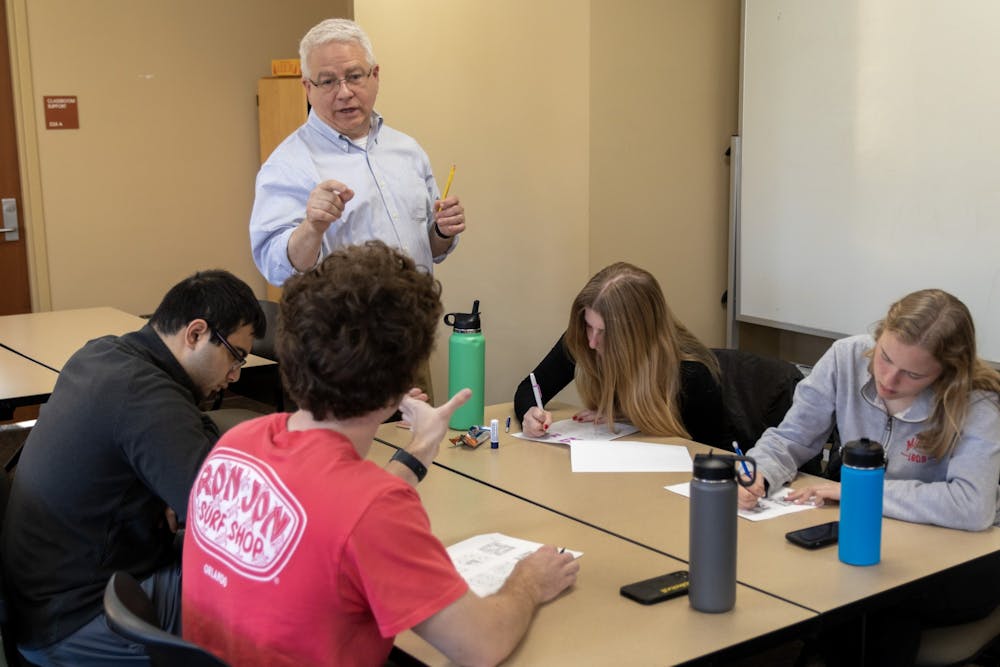On Tuesdays and Thursdays, Jeremy Easter wakes up earlier and more excited than most students.
Although some students might dread 8:30 a.m. classes, Easter, a first-year computer science major, can’t wait for his Beyond Sudoku class in McGuffey Hall.
“It’s a nice relief from classes that make me not want to go to them,” Easter said. “I actually want to go to this class. It’s a nice change of pace.”
The education class, cross-listed with honors, is taught by Jeffrey Wanko, a professor of mathematics education who has also written books on logic puzzles. The class was his idea.
“It’s a personal interest for me,” Wanko said. “This is my life, but it’s also my research area … It’s just been a way for me to intersect the personal interest of mine with my professional interests.”
The class isn’t focused only on the fun aspects of puzzles.
During class, Wanko encourages his students to use logic and reasoning to solve puzzles and even create their own. Wanko heavily relies on class participation, asking students what stands out to them as they look at puzzles.
Allison Liigsoo, a first-year business analytics major, took the class because she loves puzzles and needed an honors course. However, the class has supplied her with much more.
“It’s taught me to look at things in a different way,” Liigsoo said.
For other students, the puzzles have helped with ideas for post-graduation.
“I know I’m going to take these [puzzles] into my class as a warm-up,” Caleb Wright, a senior math education major, said.
Enjoy what you're reading?
Signup for our newsletter
Wanko even had a previous student who used his skills from the class to help with a big test.
“I had a student who was studying for his LSAT, his law tests, and he said doing these puzzles forced him to have to think through things step by step, and it helped him,” Wanko said. “That’s so not a goal of mine, but it was kind of an unintended consequence, a good one.”
Wanko’s joy for the class shines through his students. This is the fourth time Wanko has taught this class in 23 years, and he hasn’t grown tired of it.
“It is way too much fun for me,” Wanko said. “I have students who come to me afterwards, even years later and say, ‘I’m still doing those puzzles, and I found them so helpful.’”
Shikaku Puzzles
Shikaku puzzles were developed by the Japanese puzzle magazine Nikoli. The word shikaku roughly translates to “divide by box” which is a good description of this puzzle.
The goal of a Shikaku puzzle is to divide the grid into rectangles following these rules:
Each rectangle contains exactly one circled number.
The area of each rectangle matches the circled number.
Each square of the grid must be included in exactly one rectangle; in other words, every grid square must be used and no rectangles may overlap.
Each puzzle has exactly one correct solution.
A sample of a shikaku puzzle and its respective solution.
Some solving hints:
Use a pencil, not a pen. Make sure you have an eraser nearby.
Don’t make any guesses. Use deductive reasoning to place rectangles in places where you know they have to go.
Look for starting numbers where the corresponding rectangle can only be drawn one way. In the sample puzzle, the three on the right side can only be contained in a one by three rectangle drawn to the left. This sets up several other numbers that have only one possible rectangle with the space that remains.
-
Since every square in the grid has to be covered by a rectangle, look for unused squares that could only be reached by one number. In the sample puzzle, the square in the top left corner can only be reached by the four below it, so the rectangle from that four must stretch up to cover the square in the top left corner.
Students in Jeffrey Wanko's "Beyond Sudoku" course created their own shikaku puzzles for readers of The Miami Student.
These are the answers to students' shikaku puzzles.




